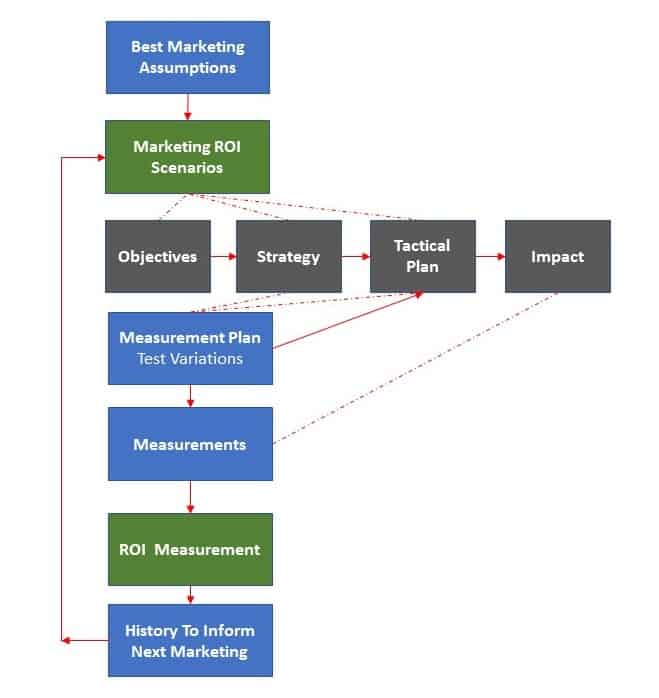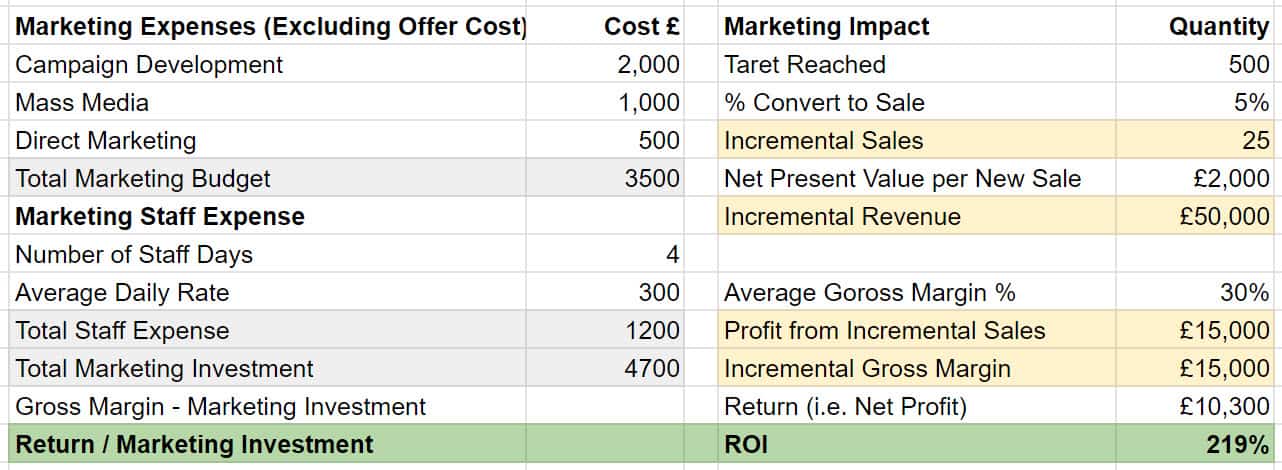Marketing ROI Planning
Should Marketing Have To Justify Its Position with Marketing ROI
The two most common questions asked by non-marketing business people are:
- “Does our marketing generate any value for the business?”
- “How do we know that marketing really works?”
Unfortunately, these questions either
- immediately put marketing on the defensive and inevitably cause marketers to conduct time-consuming and expensive analysis to justify their business function.
- if there is no actual marketing department or marketing lead mean that marketing falls under the radar whilst the business carries on trying to do business and grow haphazardly
If it is the first option this results in a significant “insight opportunity cost” since all the resources that could have been directed towards the pursuit of true insight are instead diverted to “proving” that marketing works.
Most companies will find that profits increase when constrained analytics resources are focused on the key decisions that will improve profits rather than justifying marketing’s existence.

Marketing ROI
Many businesses and marketers think of marketing ROI as reporting on the outcome of their programs, often in the form of a set of reports they have to deliver monthly.
This is not the case the best companies recognize that reporting for reporting’s sake is less important than the decisions those reports enable to improve profits.
This is the difference between backwards-looking measurement and decision-focused management.
This is why it’s important to plan your marketing activities with Return on investment in mind from the beginning. When you quantify the outcome you expect from each marketing investment, you can then determine exactly how you will measure the activity against those goals and position yourself to achieve them.
The fastest-growing companies measure ROI to find not just what works, but what works better. They focus on “improving ROI, ”not just “proving ROI. ” The statement we are doing “good” but could we be doing “great” holds true here
Planning for marketing ROI involves three main activities:
- Establishing targets and ROI estimates up-front
- Designing programs to be measurable
- Focusing on the decisions that will improve marketing
Only with discipline, planning, and a closed-loop process will you be able to improve your marketing ROI
Establish Goals and ROI Estimates Up Front
When planning any marketing investment, your first step is to quantify your expected outcomes. All too often, marketers plan programs and commit their budgets without establishing a solid set of expectations about what impact they expect the program to have.
This is a terrible habit and unfortunately one that has become more common place as marketing is delegated to untrained, un qualified staff. This is one of the underlying reasons why other executives, especially MD’s, FD’s and CEO’s, question marketing investments.
The solution is to assign up-front goals, benchmarks and KPIs for each marketing program.
The first step of any marketing activity action plan should be to define your objectives and then pick measurable metrics to support those goals. What if each PO came with an ROI plan. Within the plan you would showcase the best case, worst case, and expected case scenario outcomes. All of which would the critical but basic question of “what do we expect will happen in exchange for this money we want to spend (invest)?”
Benefits of ROI goals
With ROI goals in place, the MD’s and FD’s will see not only the cost that is spent, but also exactly what benefit is expected to come from that cost. As a result, they may be much more likely to support the investment.
In all these situation you should never worry too much about the fact that you are making estimates. As long as they are clearly labelled, the FD will understand that any plan requires numerous assumptions. Think about the accountants and bean counters within the organisation who are making financial guestimates. Just the fact that the marketer is walking in the door with a spreadsheet of numbers establishes that marketing is speaking the FD’s language. That in itself is highly effective for building credibility. Note The legendary Professor Malcolm McDonald always used to say that every marketer should know how to be an accountant. I thin he may also have mentioned that every accountant should be qualified in marketing
Modelling your ROI goals will also help you to:
- Identify the key profit drivers that most affect the model and ultimately your profits.
- Create “what if” scenarios to see how changing parameters may vary the results and impact profitability
- Establish the targets you will use to compare actual results
How to build models for ROI goals
Not every program will have a complete ROI calculation. Some programs will have softer goals, such as number of attendees at an event, but as always, the closer you can get to measuring profits and ROI, the better you will justify the investment.
Even the simplest ROI goals should include:
- How many incremental sales are generated
- How much revenue each sale produces
- The gross margin percentage
- The total marketing and sales investment
Here’s an example ROI calculation, courtesy of Acme Group. Note how it captures all expenses including all variable costs on the left, and focused on incremental gross margin on the right
Lenskold Group provides excellent tools for managing marketing ROI, including an online Lead Generation ROI planning tool. This and other tools are available for free from the Lenskold Group website
Acme Group Basic ROI Calculation

Marketing ROI – Understand Best Case, Worst Case, and Risks Scenarios
The best plans show a range of targets, including expected case, best case, and worst case scenarios. This lets you protect your credibility in case things go sour, and shows an understanding of how changes to various assumptions might impact the results.
It also shows that you understand the possible risks that would hurt your program’s ROI. It’s often a good idea to run your assumptions and targets by the most sceptical and pessimistic member of your team. Let them find all the ways the program could fail – and then, where possible, put in place contingencies to manage the risks. This may include things directly related to the program, but it can also include broad changes to the business environment and economy. By proactively identifying and managing risks up-front, you lessen the likelihood that other executives will shoot bullets at your feet later on
Make sure you incorporate all relevant expenses
Often, marketing ROI models show ridiculously high returns because they don’t incorporate all relevant variable and semi-variable costs. Examples include:
- Staff costs within marketing
- Travel expenses
- The cost of sales’ time spent following up on leads
Take, for example, a program that generates a lot of leads but does not include the cost of the time sales wastes on pursuing leads that don’t convert.
It’s quite possible that a program that at first appears profitable will show a negative ROI once these expenses are included
It should be added that for manufacturing companies these irregularities occur in many other areas. I have seen large equipment manufacturers not include “design time” within projects. Or new product development projects that get to go live – but don’t take into account any of the development costs !
Design your marketing campaigns to be measurable
The best marketing programs have intentional measurement strategies planned in advance. So as part of planning any program, you need to answer these three questions:
- What will you measure?
- When will you measure?
- How will you measure?
In almost every case, you will need to take specific steps to make your marketing programs measurable. This often includes setting up test and control groups or varying your spending levels across markets to measure relative impact.
Without variance in your marketing, you may not be able to use modelling to tease apart the incremental impact of your marketing programs and improve your marketing precision and mix.
Marketing Data Collection
A key part of planning for measurement is simply tracking the appropriate attributes for all your marketing programs (and their variants). This can include target audience, message, channel, offer, investment level, and any other relevant attributes.
Capturing “market data / market intelligence” in a way that will be accurate, consistent and easy to manipulate is a very important activity. This is where customer relationship systems can be worth there weight in gold in the future. If they have been set up and utilised correctly.
Most companies do not begin this process early enough in their lifecycle, and they pay for it later. Even if you don’t use the data right away, it will become invaluable down the road when you attempt any of the more sophisticated approaches towards measuring program effectiveness.
These attributes can be stored in anything from your marketing automation system to a simple spreadsheet hosted on a share drive – what matters the most is that you start to build the history as early as possible.
Marketing Reporting – Just Because You Can Doesn’t Mean You Should
A very wise man once told me there is Data, then information, then knowledge. Many companies collect and collect vast quantities of data.
What this means is it’s important not to measure just what you can, but what you can ACT on. Think about where you want to end up before you begin, and strategize from there.
Ask yourself, “What question am I trying to answer, and what would I do if the answer were X or Y? A very simple example of this is when you see companies creating surveys and the end up asking questions that when answered provide no value
Focus on the Decisions that Improve Marketing
You’ll deliver the best ROI and reap the highest corollary benefits when you move past backward-looking measurement to forward-looking decisions.
This is the difference between marketing measurement and marketing management. It is the difference between data, intelligence, and knowledge.
An integral part of your planning process is identifying up-front what decisions you need to make to drive company profits, and then building your measurements to capture information that facilitates these decisions.
This means you must measure things not just because they are measurable – but because they will guide you towards the decisions you need to make to improve company profitability.
Isn’t it time to swap your over-the-shoulder stance, which prevents you from moving forward efficiently, for strategic, objective-driven momentum?
Your highest-ROI decisions will often flow from strategic questions about offers, messages, target segments and geographies –not simply “pass/fail” assessments of specific programs or tactics. You can always evolve your mix of tactics, but even the best tactics applied across the wrong strategies won’t produce a fraction of your desired results.
In other words, marketers should focus beyond “what is” and start measuring “what if.”
Each measurement should seek to augment your understanding of how to make the program better and align it with your company’s strategic objectives. This way, even if you don’t meet all of your program goals, you can still figure out why and how to improve the program. This is almost always better than launching a new program you don’t yet know anything about.
Next time your website designer tells you that you have had xxxx number visitors, start digging and get them to explain what information and knowledge they can provide
Marketing ROI Planning, Metrics and Analytics
If you would like to know more about marketing metrics and analysis contact Andrew Goode MBA, MSc, FCIM Click here to arrange a call
If this article has been of interest you may find the article on marketing Metrics and Analytics useful




